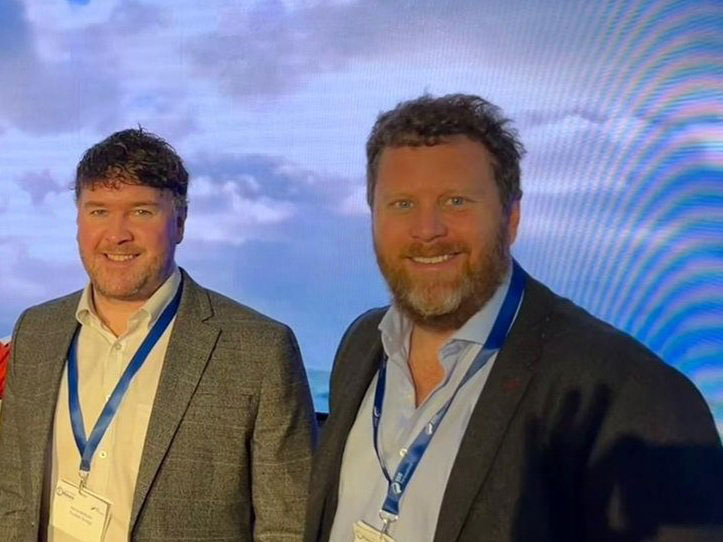The Wind Energy Ireland Offshore Conference took place last week in Dublin, with Barrie and Richard from our Ireland projects’ team there to discuss all things Flotation Energy. We caught up with Flotation Project Manager, Barrie McMullin to get his thoughts on the event:
Barrie, tell us who’s at the event and what’s everyone talking about?
There’s a fantastic mix of developers, supply chain, industry bodies and Government at the Wind Energy Ireland Offshore Conference. The wide mix of people really demonstrates Ireland’s strong commitment to the offshore wind industry.
As the developers of Kincardine, the world’s largest grid-connected floating offshore wind farm, Flotation is extremely well positioned to be developing one of Ireland’s first commercial floating offshore wind farms, Blackwater. Floating technology is very much the future of the industry, and we are very excited to be part of the phase 2 projects that are going to materially contribute to Ireland’s green economy.
In terms of speakers, the selection of representatives and the topics presented were of exceptional quality. Pre-eminent economist and journalist David McWilliams delivered a passionate appeal to policy makers, developers, manufacturers and industries bodies alike: we are at a crucial point in (energy) history and it’s up to us all to pull together and make the Irish wind energy vision happen.
What’s your key take aways from the event?
There’s a fantastic buzz coming out of Ireland right now regarding offshore wind and in particular great discussions around the opportunities there in the region. A lot of developers are clamouring to progress their developments, so we find ourselves facing fierce competition. But as one of only four floating developers worldwide, we are confident in the success of Blackwater.
Ireland currently has 51 offshore wind projects under development but only 2 in construction, so it’s a busy time with lots of planning and scoping to prepare for the future. Ireland is fast-tracking its offshore wind sector in line with its Climate Action Plan 2021 . Its aim is to increase the country’s offshore wind capacity to 7GW as part of the Irish Government’s ambition to deliver 80% of electricity from renewable sources by 2030. To do this, they require the Phase 1 projects to come on stream very soon, with Phase 2 projects following close behind!
Recent political events have catapulted the desire and the very real need for Europe to become energy independent and this requires a consistent, collaborative and accelerated effort across not just industry, but across government and key state companies too. Creating a new, secure zero-carbon energy system is one of the biggest infrastructural challenges we’ve faced in current times, and how we work together to achieve this, using the best people and the comprehensive engineering and industrial knowledge we have within the region, will be paramount to achieving this goal.
What challenges were highlighted at the event?
The biggest challenge for developers, as was repeated by many of the wonderful presenters, are the “3 Cs”:
· Certainty
· Confidence
· Clarity
Developers need more certainty from the government around the requirements and timelines of surveys and licences, chief among those are the foreshore licences that can take up to 18 months to obtain. With only 8 years to consent, construct and commission 7GW worth of wind farms, this process is too lengthy.
Developers and investors alike need to be given confidence to commit significant sums now to undertake the surveys and studies necessary to meet very ambitious project timelines. The Irish government needs to provide clarity around the timeline of the specific milestones in the development process. Only then can the immense Irish offshore wind potential be realised.
Another of the challenges discussed this week came out of a comprehensive report launched at the conference, and it highlighted a lack of ports ready to accept offshore wind construction projects in the region. The National Ports Study identified just one harbour (Belfast) as currently suitable to deliver these milestone projects.
The positive news is that this challenge could be solved with support from the Irish Government to de-risk the level of up-front investment required to upgrade Irish ports. If that happens, these could be ready by 2025-26, which would match up with the construction phase of the wind farm developments and enable Ireland to manage contracts in the region; ensuring high-skilled jobs are retained and nurtured in-country.
What are the opportunities being discussed?
Floating wind is seen as an attractive technology because it provides much better access to deeper waters and higher, more constant wind speeds than conventional fixed structures. Floating wind expands the potential areas available for development, helps to reduce visibility issues from shore and overall minimises the impact on both the marine environment and other seabed users.
Ireland has fantastic engineering expertise that will support offshore wind into a successful and exportable commodity. Uniquely positioned in Europe, Ireland’s natural resource with high constant wind speeds and vast coastline suitable for floating offshore wind, makes it a prime location for fixed and floating projects.
Finally, what did you enjoy the most about Offshore Wind Ireland this year?
It’s always great to get out and about and meet peers and industry leaders, especially after the hiatus of the past two years. Hearing from key stakeholders about the challenges and the issues affecting the industry, as well as having first-hand exposure to the concerns and hopes / wants from public opinion is extremely useful also. And of course, it’s exciting being part of a forum where we can discuss how Floatation’s vast expertise and innovative solutions in offshore windfarm development can support the energy transition challenges in Ireland.



